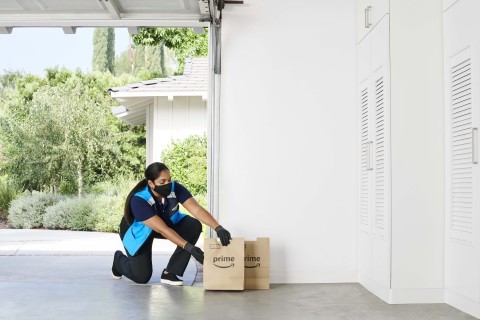Small warehouse facilities in population centers facilitate super-quick deliveries
The growth of e-commerce in the United States has influenced the strategies of industrial real estate investors, who are increasingly on the lookout for smaller properties in metropolitan areas. Fulfillment facilities located within population centers allow e-commerce vendors to better meet consumers’ expectations for quick deliveries.

Amazon Factor
Amazon has invested heavily in the groceries sector, starting with its 2017 takeover of Whole Foods, and the online behemoth is also in the process of opening a new grocery chain. Amazon Fresh, targeted to its Prime members looking for lower prices, incentivizes them to use online ordering with free two-hour deliveries and the elimination of monthly fees.
Amazon will be using its new stores—along with its Whole Foods locations—as distribution centers to support online grocery sales. That strategy is representative of what many grocers are doing to move their inventories closer to customers in an effort to minimize transportation costs and reduce delivery times. A growing number of companies, including Albertsons, ShopRite, Meijer, and Stop & Shop, are also using micro-fulfillment centers to do just that—and to reduce reliance on in-store fulfillment.
Micro-fulfillment centers can be located in the back rooms of stores, in dark stores— where all or part of a brick-and-mortar location is converted into an employee-only mini fulfillment hub—or in small dedicated e-commerce distribution facilities. Micro-fulfillment comes largely to replace in-store fulfillment, which causes “order pickers to compete with customers, creating congestion and leaving items out-of-stock more frequently,” said Rueben Scriven, a senior analyst at Interact Analysis.
In addition, Scriven added, “store lay-outs are designed for customers, not pickers, resulting in lower order-picking efficiencies.”

Micro-fulfillment also allows retailers to control the shopping experience, eliminating the need to outsource the process to third parties. Retailers thereby retain ownership of important consumer data, and, by deploying data-crunching software, are able to detect buying patterns and brand preferences and develop improved personalized shopping experiences. Market research studies indicate that 69% of consumers are likely to shop at a competitor after just one bad online experience and 65% say they want personalized recommendations from their online retailers.
Groceries are largely responsible for Walmart’s e-commerce growth in the last two years, and the retailing giant has embarked on a micro-fulfillment strategy by establishing what it calls market fulfillment centers (MFCs), first piloted in Salem, New Hampshire, in late 2019. MFCs are “compact, modular warehouses built within, or added to, a store,” said Tom Ward, a Walmart senior vice president.
Compact and High Density
Micro-fulfillment centers are fundamentally compact and high-density, one reason why implementing the right technology is important to their success. In Walmart’s case, “automated bots retrieve the items from within the fulfillment center,” said Ward, and bring them to a picking workstation. But the human element is not eliminated, as personal shoppers ensure that fresh items like produce, meat, and seafood are up to standards. The system promotes quicker picking, according to Ward, allowing orders to be delivered or made available for pick up within an hour.
Walmart will be building MFCs “with various technology partners,” said Ward, including Dematic, which also automated micro-fulfillment centers for PepsiCo and the U.S. grocer Meijer, the first company to implement Dematic’s micro-fulfillment solution. Meijer sees micro-fulfillment as one way “to make shopping easy and convenient,” according to Sid Handa, the company’s director of strategic supply chain initiatives. Dematic’s “micro-fulfillment technology allows us to maximize space in our stores, help us expand our online shopping options, and keep pace with consumer demand for personalized shopping solutions.”
Dematic is a leading provider of technology for micro-fulfillment centers, according to Scriven, as is Takeoff Technologies, which, in 2019, signed a $150 million deal with Knapp AG, a warehouse automation company, to build 50 micro-fulfillment centers across the U.S. that process $1.5 billion in annual e-commerce grocery sales. Woolworths, Wakefern Food Corp., ShopRite, Albertsons, and Sedano’s Supermarkets, Scriven noted, have all partnered with Takeoff Technologies to establish micro-fulfillment centers within the last couple of years.
Dematic’s micro-fulfillment solution can be installed in locations as small as 10,000 square feet and accommodates ambient, cold, and frozen temperature zones. The solution uses a multi-shuttle system, which stores and sequences products among bulk stock, picking, and order-assembly locations to increase speed, density, accuracy, and throughput.
“The compact design makes it possible to install in the back of existing retail locations, supporting online orders for consumers within a specific radius,” said Hasan Dandashly, the company’s CEO. “That enables companies to better use space in existing stores, streamline e-commerce order fulfillment and last-mile delivery, and provide a better consumer experience online and in-store.”
The 10,000 square-foot scale accommodated by Dematic is typical of the size of automated micro-fulfillment centers, according to Scriven. Such a facility would cost “approximately $4 million to build,” he said, “and house roughly 15,000 SKUs.”
That’s about one-quarter of the number of SKUs found in a typical large U.S. supermarket, Scriven noted, leaving “slow-moving SKUs to be picked from within the store.” “Most micro-fulfillment sites will leverage brick-and-mortar stores,” he added, at least for now, while “extensions to current real estate may become prevalent” down the road. In two years, Scriven projected, micro-fulfillment centers will account for 20% of U.S. business spending on grocery warehouse automation.
Dematic’s Dandashly believes that groceries represent just the beginning of the micro-fulfillment phenomenon. “The retail market is ripe for automation disruption,” he said, and Dematic has been receiving robust interest “from leading retail brands wanting to know more about micro-fulfillment.
“We began this by helping our grocery customers,” Dandashly added, but “general merchandise and apparel represent a natural next step.”




